Physical Address
304 North Cardinal St.
Dorchester Center, MA 02124
Congenital lesions of the neck consist of a variety of entities, some of which become apparent at birth or shortly thereafter, whereas others present later in life. This chapter will focus on congenital lesions that can be recognized in the fetus or the newborn. Many congenital cervical lesions may be diagnosed prenatally, making it essential for pediatric radiologists to be familiar with their general patterns on fetal imaging.
Presence of mass lesions in the fetal/neonatal neck may considerably influence other organs and systems because of the complex anatomy of the neck and the proximity of the lesion to vascular, upper gastrointestinal, and especially airway structures. Conditions that may result in potentially life-threatening trachea-laryngeal obstruction include extrinsic causes such as cervical teratomas, vascular malformations, and vascular rings, and intrinsic causes such as congenital high airway obstruction syndrome (CHAOS) and upper airway hemangiomas. Giant fetal neck masses may grow to obstruct the esophagus, causing an accumulation of amniotic fluid (polyhydramnios) and increasing the risk of preterm labor. Accurate depiction and distinction of these entities with imaging facilitate prenatal counseling and delivery planning. Some congenital cervical lesions may be associated with other serious anomalies and may be the first manifestation of a systemic disease or syndrome, potentially requiring further investigation. For accurate diagnosis, it may be necessary to utilize complementary imaging modalities.
Imaging tools for the fetal neck are ultrasonography (US) and magnetic resonance imaging (MRI). The neonatal neck may be assessed by US, computed tomography (CT), and MRI. Rarely, indeterminate vascular lesions may require evaluation with conventional angiography. Lateral radiography of the neck may still be used in emergent initial evaluation of upper airway pathology but is rarely of value in the workup of congenital lesions.
US supplemented by Doppler (for evaluation of blood flow) is a noninvasive, real-time, high-resolution imaging modality, which provides excellent anatomic images. It is equally useful for primary obstetric imaging and for portable bedside evaluation of a neck mass in the distressed child. Obstetric US includes routine evaluation of the head, face, and neck, as well as an assessment of airway patency and fetal swallowing. The swallowing pattern may be difficult to confirm with US, hence ancillary signs of upper gastrointestinal (GI) tract compromise (a small stomach or polyhydramnios) should be routinely searched for. US nicely demonstrates a lesion's morphology, reliably distinguishes the cystic and solid components, and shows fat and calcifications. Color Doppler depicts the major neck vessels, demonstrates a lesion's vascularity and blood supply, and detects possible arteriovenous shunting. Three-dimensional US clearly depicts the relationship of a cervical mass with adjacent facial and skull base structures ( e-Fig. 14.1 ). Potential shortcomings of fetal US involve cases with poor acoustic windows or abnormal fetal position with unusual flexion and extension of the fetal neck. US imaging of neck lesions in young children is performed with high-resolution transducers and may be sufficient for immediate diagnosis. However, assessment of surrounding tissue invasion may be suboptimal.
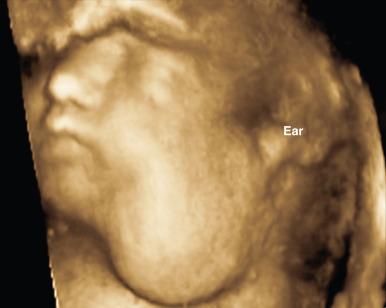
CT may serve as the initial imaging modality for evaluation of congenital lesions; it is widely available and offers fast data acquisition. However, suboptimal soft tissue resolution and continued concerns of radiation exposure have resulted in decreasing use in recent years.
MRI is a superb imaging modality for the evaluation of fetal or neonatal neck lesions. Fetal MRI is considered safe to perform in the second and third trimesters, and is approved by the US Food and Drug Administration (FDA) for magnet field strengths up to 3.0 Tesla. Fetal MRI before 17 weeks of gestational age is typically of little value because of the relatively poor image quality in a small fetus and is avoided because of the unknown safety of exposure to magnetic fields during organogenesis. Fetal MRI is usually performed for further assessment of a cervical mass detected by routine obstetric US. The MRI protocol for fetal neck imaging includes the following: (1) half-Fourier acquisition single-shot turbo (HASTE) magnetic resonance (MR) sequence (excellent for imaging of normal anatomic structures and depiction of cervical lesions); (2) spoiled gradient echo T1-weighted sequence (helpful for imaging the thyroid gland and blood flow within the major cervical vessels, as well as for depiction of intralesional blood products and calcification); (3) gradient echo planar imaging (helpful for detection of blood products, calcification, and bony detail); and (4) dynamic steady state or balanced gradient echo sequences (valuable in the assessment of swallowing function in the fetus [see ![]() ]). The details of fetal swallowing and possible airway compromise should always be carefully examined. Knowledge of airway status may help facilitate delivery planning, including use of the Ex Utero Intrapartum Treatment (EXIT) procedure to allow time to secure the airway while the neonate is still attached to the umbilical cord.
]). The details of fetal swallowing and possible airway compromise should always be carefully examined. Knowledge of airway status may help facilitate delivery planning, including use of the Ex Utero Intrapartum Treatment (EXIT) procedure to allow time to secure the airway while the neonate is still attached to the umbilical cord.
MRI sequences for imaging neonatal neck lesions include high-resolution thin T1- and T2-weighted and postcontrast imaging with fat-suppression in orthogonal planes. Diffusion-weighted imaging is useful for characterization of hypercellular tumors and infected cystic lesions with viscous, purulent content.
The Mulliken and Glowacki classification of vascular lesions divides pediatric vascular lesions into two major categories: (1) vascular tumors and (2) vascular malformations. These lesions have different treatments and prognoses. The classification, based on pathologic differences as well as the clinical and cellular behavior of vascular lesions, was widely accepted and adopted by the International Society for the Study of Vascular Anomalies in 1996 and was expanded in 2014. Some additional entities have since been identified that are complex and less easily classified by generic headings. Vascular tumors are classified as benign, locally aggressive or borderline, and malignant. Some known genetic defects underlying vascular anomalies have been discovered. Despite the recent revisions, this classification should not be perceived as a final arrangement. A better understanding of the molecular biology and genetics of vascular anomalies may lead to further refinement of the existing classification system.
Hemangioma is the most common vascular tumor of infancy. It is a true endothelial tumor with increased mitotic activity during the proliferative phase and eventual involution. Two major types are recognized: (1) congenital (rare) and (2) infantile (common). The previously used categorization of hemangioma types as capillary, juvenile, or cavernous is no longer accepted. All types of hemangiomas have overlapping clinical, imaging, and histopathologic features.
Infantile hemangiomas are benign vascular neoplasms with an increased incidence in premature children with low birth weight. These lesions have a predictable clinical course of growth and involution which progresses through several stages. The nascent phase, with a subtle precursor lesion (macula, multiple telangiectasias, or discoloration), may be observed in the first 2 to 4 weeks of life or may be present at birth. The proliferative phase is remarkable for rapid tumor growth in the first year of life. In the proliferative stage, the hemangioma appears as a bulky, compressible lesion of strawberry-red color and may have cutaneous as well as deep components. On cross-sectional imaging, it appears as a lobulated mass with intense uniform enhancement, usually with presence of intralesional flow voids on MRI ( Fig. 14.2 ). Proliferation may be biphasic. Careful assessment of upper airway status is important because the deep portions of a cervical hemangioma may enlarge at this stage sufficiently to impinge on the airway and cause obstruction. The final involution phase may continue for up to 12 years, as the rate of regression is variable. Involution is never complete as there is residual fibro-fatty tissue, although the residual lesion may not be grossly visible. Infantile hemangiomas are positive for the glucose transporter 1 (GLUT-1) marker at all stages of lesion development. Most infantile hemangiomas do not cause any morbidity or mortality but may create cosmetic inconvenience. On the other hand, a hemangioma of the neck is considered an alarming lesion if it assumes a beard distribution (involvement of the lower face, anterior neck, and submandibular and parotid regions) because of the high risk of airway compromise and an increased incidence of subglottic hemangioma. In addition, cervical and facial infantile hemangiomas have a known association with PHACES syndrome ( P osterior fossa malformations, H emangiomas, A rterial, C ardiac anomalies, E ye anomalies, S ternal cleft). The arterial anomalies often seen in PHACES syndrome represent a spectrum of congenital arterial lesions ipsilateral to the cutaneous hemangioma. This necessitates careful searching (and monitoring) with imaging for potential vascular abnormalities once a diagnosis of segmental hemangioma is established. Infantile hemangiomas involving the upper airway ( Fig. 14.3 ) become symptomatic in the proliferative phase, causing biphasic stridor, respiratory distress, and potentially life-threatening airway obstruction, which may require emergent intubation. These hemangiomas are often multifocal and occur above and below the vocal cords. Close monitoring with cross-sectional imaging is indicated because laryngoscopy may not accurately depict the degree of invasion. MRI is preferred in the setting of intubation or tracheostomy. In rare cases, mostly in the setting of underlying PHACES syndrome, segmental infantile hemangioma may be associated with central nervous system hemangiomas in intracranial ( e-Fig. 14.4 ) or intraspinal locations. In the past, infantile hemangiomas have been confused with other vascular neoplasms, particularly kaposiform hemangioendothelioma (KHE) and tufted angioma, especially in the setting of consumptive coagulopathy (Kasabach-Merritt phenomenon). It is now generally accepted that infantile hemangiomas are rarely, if ever, responsible for this phenomenon.
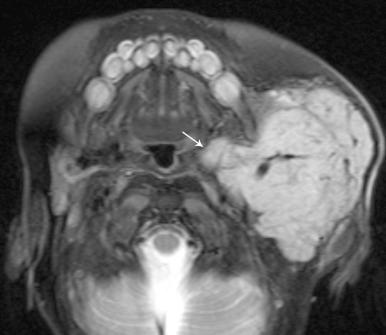
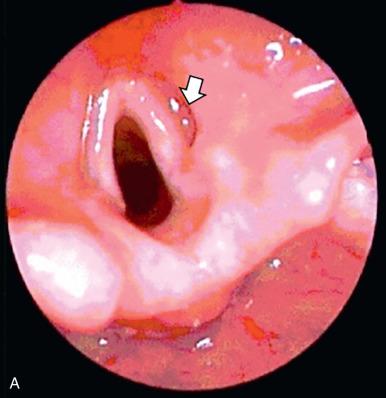
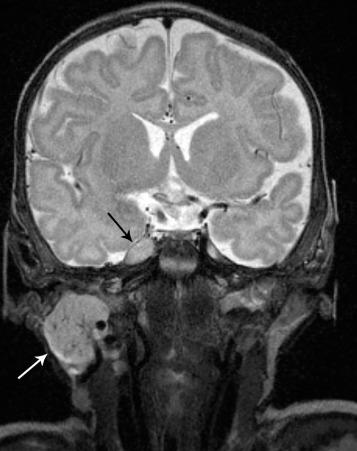
Congenital hemangiomas are uncommon lesions that are fully developed at birth and do not undergo a proliferative stage in postnatal life. These lesions may be diagnosed in utero as early as 12 weeks of gestational age. Two types of congenital hemangiomas are described: (1) rapidly involuting congenital hemangioma (RICH) and (2) noninvoluting congenital hemangioma (NICH). A partially involuting type (PICH) has also been described. RICH has a predilection for scalp and neck locations. On prenatal imaging, it appears as a large heterogeneous mass, emanating from the posterior neck ( e-Fig. 14.5 ) with increased vascularity, best demonstrated on obstetric Doppler US and MR gradient echo planar imaging. Postnatal imaging features of RICH include large irregular flow voids and arterial aneurysms, direct arteriovenous shunts (seen on angiography), and calcifications. Their imaging appearance may occasionally resemble congenital infantile fibrosarcoma. Large RICH lesions may have a dramatic presentation at birth with high-output congestive heart failure ( Fig. 14.6 ). Rapid involution is usually completed by 14 months of age. Usually, RICH is managed conservatively, although complications may prompt surgical excision. NICH, on the contrary, never involutes and may even grow with the child. It usually has an imaging appearance similar to infantile hemangioma, being more homogeneous with uniform parenchymal enhancement.
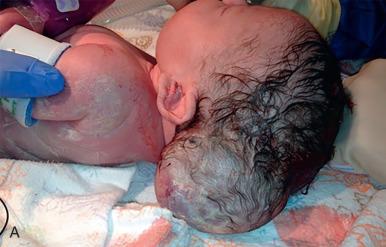
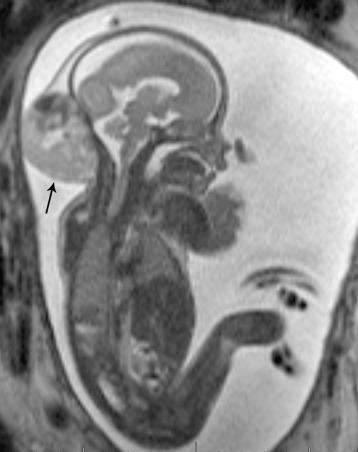
Most hemangiomas resolve spontaneously, however, approximately 10% to 20% require treatment, which includes pharmacologic, surgical, or laser intervention. Treatment is indicated in cases when functional or cosmetic complications arise that are worse than the side effects of intervention. Lesion size and location, patient age, and phase of the lesion (proliferative, involuting, and mature) also influence the method and timing of intervention.
Become a Clinical Tree membership for Full access and enjoy Unlimited articles
If you are a member. Log in here